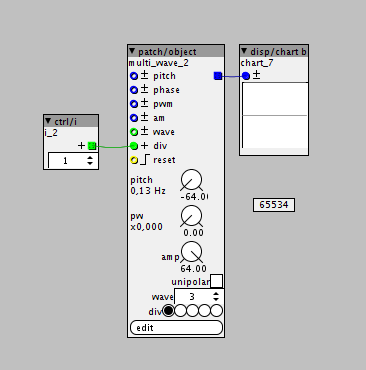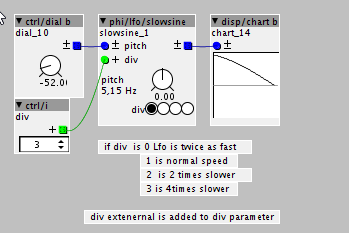I would like to code a slower lfo, is there a way to modify the existing LFOs and make them slower?
How to code slower LFOs
It's possible, but the speed of the LFO won't reflect the values on the dial.
This approach might work, but I haven't tested anything since I don't have an Axoloti board near me.
If you take a look at the code of lfo/saw, you'll notice this piece of code:
MTOFEXTENDED(param_pitch + inlet_pitch,freq);
Phase += freq>>2;
The pitch of the inlet and the parameter dial are converted into a frequency. The freq variable is then added to the phase.
You can slow the LFO down if you divide the pitch with a number, in this case 2. You can also add a parameter to set this number.
MTOFEXTENDED( (param_pitch + inlet_pitch) / 2, freq );
Thanks Jan!
It only works somehow if i not divide thru 2, but instead multiply with 2.
Wich yields a slower but also faster lfo...
I am also not able to add an inlet_coarse
slolfo.axp (3.9 KB)
what if you adjust the bitshift after freq so instead of:
Phase += freq>>2
you try:
Phase += freq>>4 ??
nice!
your comment shoud read:
0 is twice as fast 1 is normal speed 2 is half speed and 3 is quarter speed.
otherwise it is very unclear, because you mix slower/faster double/half and longer... 
also after 1 comes 2, hehe...
I wonder how slow the lfo could go ..for instance i set the Lfo to 1Hz, how do i calculate the slowness, if div in is 10? (slowness would be ~7 hours) or how about div = 65533?
.
The limit is when the phase increment is a single unit, resulting in a period of 2^31 k-rate cycles (@3kHz), 715827.88 seconds or 8.2 days. The next frequency is a phase increment of two units, 4.1 days, just to illustrate that the resolution is not too great at that point.
Or expressed in frequency, the frequency resolution is 3kHz/2^31 = 1.397 microHz
More resolution can be obtained by using 64bit integer phase if you plan a new take on ASLSP 
Thats not enough for me 
so what would be the slowness if i used the 64bit integer approach?
The slowest period would be 97 million years ((2^63)/3kHz)
or frequency resolution of 0.325 femtoHz
Well, that is only theory (and assuming my calculations are correct), I'd be happy to leave the testing work to you...

